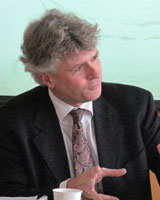Personalia
Jeroen Duindam, born in Utrecht, the Netherlands, in 1962. Ph.D. from Utrecht University. Professor of Early Modern European History at Leiden University.
Fellow (1 September 2014 – 31 December 2014)
Dynasty: A Global History 1300-1800
Research Question
Which cross-cultural patterns can be established in global practices of dynastic rule from the Mongol conquest to the phase of unchallenged European military and economic hegemony?
Project Description
Dynastic forms of power are dominant in history, across boundaries in space and time. During my previous NIAS fellowship I examined dynastic extended households in Asia, Africa, and Europe, with occasional other examples. Four chapters focus on 1) the ruler: position versus person; 2) the dynasty: succession and reproduction; 3) at court: spatial arrangements and recurring tensions; 4) realm: connections and interactions with the population.
The resulting study written largely in the course of the second semester of 2013-2014 will be corrected and prepared for publication in the first semester of 2014-2015. The book provides a structural and global analysis of the dynastic setup, showing the relative weakness of rulers, examining the role of women, outlining the tense relationship between rulers and successors, positioning the ruler among his servants, and the court in the wider setting of the realm. The inclusion of African kingship and matrilineal descent helps to question common definitions of dynasty and to break free from the restrictions and clichés of Asia-Europe comparisons.
Selected Publications
1) Vienna and Versailles. The Courts of Europe’s Dynastic Rivals, 1550-1780 (Cambridge 2003); paperback edition Cambridge 2007; Italian (2004) and Spanish (2009) translations.
2) Myths of Power. Norbert Elias and the Early Modern European Court (Amsterdam 1995)
3) (with co-editors Metin Kunt and Tulay Artan) Royal courts in dynastic states and empires: a global perspective (Leiden; Boston 2011) available through open access.
